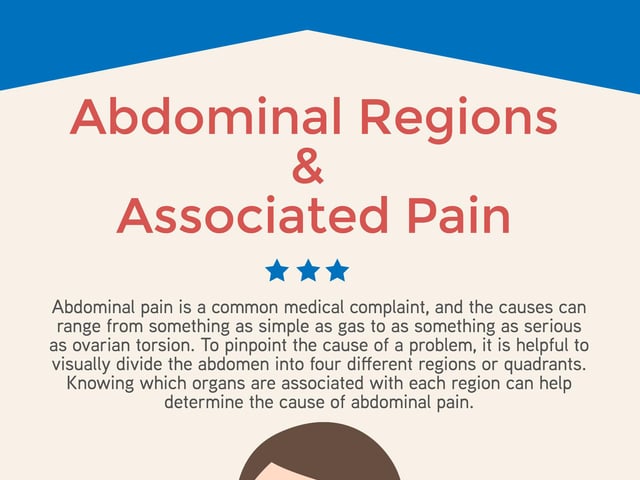
Abdominal Regions and Associated Pain
Understanding the various regions of the abdomen and the potential sources of pain in these areas is critical for pre-nursing students and anyone studying for the TEAS exam. This knowledge is not only relevant for the test but also plays a pivotal role in real-life nursing scenarios.
The Nine Abdominal Regions
In medical study and practice, the abdomen is divided into nine regions to facilitate a systematic understanding of its anatomy. These regions offer a comprehensive, focused view of the abdomen, which assists in accurately locating and describing anatomical structures, potential health issues, and sources of discomfort or pain. The nine regions provide a roadmap of the abdomen, simplifying navigation, and enabling a more precise diagnosis.
Upper Abdomen
The upper abdomen, located below the ribcage and above the naval, is composed of three primary regions. Understanding the anatomy contained within these regions is essential to identify potential health concerns associated with each area.
-
Right Hypochondriac Region: This region is located beneath the ribs on the right side. The most significant organ in this region is the liver, which performs various critical functions, including detoxifying harmful substances, storing vitamins and iron, and producing bile for digestion. Close to it is the gallbladder, a small organ that stores bile produced by the liver. Pain in this region might indicate a problem with these organs, such as gallstones or liver disease. Also in this region is the right kidney, which filters waste from the bloodstream to form urine.
-
Epigastric Region: This central region is located just below the sternum (breastbone) and above the naval. The primary organ in this area is the stomach, which receives food from the esophagus and begins the digestion process. Next to the stomach is the pancreas, which releases enzymes to aid in digestion and hormones like insulin and glucagon. The upper parts of the liver and kidneys are also found in this region, contributing to its high density of essential structures.
-
Left Hypochondriac Region: This area lies under the left lower ribs. It houses the spleen, an organ involved in the production and removal of blood cells, as well as immune response. Part of the stomach and the left kidney are located here, as well as parts of the pancreas.
Middle Abdomen
The middle abdomen, often referred to as the midriff, encompasses the area between the upper and lower abdomen. It’s a hub of many significant digestive organs and structures.
-
Right Lumbar Region: Positioned on the right side of the abdomen, under the right hypochondriac region, it includes the ascending colon – part of the large intestine where water and electrolytes are absorbed from partially digested food. This region also contains the right edge of the small intestines, responsible for most of the digestion and absorption of nutrients.
-
Umbilical Region: This region surrounds the umbilicus, or belly button, and includes parts of the small intestines, specifically the jejunum and ileum, which continue the process of digestion and absorption. It also includes the transverse colon, the longest part of the colon, which plays a role in water and electrolyte absorption, and helps transport waste material.
-
Left Lumbar Region: Located under the left hypochondriac region and contains the descending colon – part of the large intestine responsible for storing feces that will be emptied into the rectum. Also located here is the left edge of the small intestines.
Lower Abdomen
The lower abdomen, positioned below the umbilicus and above the pelvic bone, consists of three key regions:
-
Right Iliac (Inguinal) Region: Also known as the right lower quadrant, this region includes the cecum, the starting point of the large intestine, and the appendix – a small, tube-like structure attached to the cecum with no known essential function but can become inflamed and cause problems (appendicitis). In females, it also contains structures like the right ovary and fallopian tube.
-
Hypogastric (Pubic) Region: Located centrally in the lower abdomen, this region contains the urinary bladder, responsible for storing urine. It also includes the sigmoid colon – the final section of the large intestine that holds feces before they’re eliminated during a bowel movement. In females, this region includes reproductive organs such as the uterus and ovaries.
-
Left Iliac (Inguinal) Region: The left lower quadrant of the abdomen houses the initial part of the sigmoid colon. In females, it also contains structures like the left ovary and fallopian tube.
Abdominal Pain and Associated Conditions
Abdominal pain can manifest in various ways and can be associated with a range of conditions, from mild and temporary to severe and chronic. Understanding the types of discomfort and their location can provide essential clues to potential underlying diseases or conditions. It’s crucial to remember that pain can sometimes be referred, meaning it originates from a different part of the body. Hence, a comprehensive review of symptoms, medical history, and clinical examinations is necessary for accurate diagnosis and treatment.
Pain in the Upper Abdomen
The upper abdomen hosts a range of vital organs, each potentially susceptible to various diseases or conditions.
-
Right Hypochondriac Region: Pain in this region may be due to gallstones (hardened deposits in the gallbladder), hepatitis (an inflammation of the liver), or other liver diseases such as cirrhosis or liver cancer. Liver diseases often present with other symptoms like jaundice, fatigue, and weight loss.
-
Epigastric Region: Pain here might be due to gastritis (inflammation of the stomach lining), peptic ulcers (sores on the lining of the stomach, upper small intestine, or esophagus), pancreatitis (inflammation of the pancreas), or cardiac conditions like myocardial infarction (heart attack). It’s important to note that heart-related pain can sometimes mimic abdominal pain due to its referred nature.
-
Left Hypochondriac Region: Discomfort in this area could indicate conditions such as gastritis, spleen damage (due to trauma or conditions like mononucleosis), or pancreatic diseases, such as pancreatic cancer or pancreatitis.
Pain in the Middle Abdomen
The middle abdomen, with its mix of digestive and excretory structures, can experience discomfort due to several reasons.
-
Right Lumbar Region: Pain in this area can indicate renal calculi (kidney stones), pyelonephritis (kidney infection), or even appendicitis, especially if the pain migrates from the umbilical region.
-
Umbilical Region: Discomfort here is commonly linked to conditions like gastroenteritis (stomach flu), small bowel obstruction (blockage in the small intestines), or appendicitis, especially in its early stages when pain is often centered around the belly button.
-
Left Lumbar Region: Discomfort in this region might be associated with diverticulitis (inflammation or infection of small pouches called diverticula in the digestive tract), renal calculi, or pyelonephritis.
Pain in the Lower Abdomen
The lower abdomen houses several organs of the digestive, excretory, and reproductive systems, and each can be a potential source of discomfort.
-
Right Iliac (Inguinal) Region: Discomfort in this region is often associated with appendicitis, where the pain might initially start in the umbilical region and then localize to the right lower quadrant.
-
Hypogastric (Pubic) Region: Pain in this area can result from urinary tract infections or cystitis (bladder infection), conditions of the sigmoid colon like colon cancer or diverticulitis, or gynecological conditions such as pelvic inflammatory disease, menstrual cramps, or conditions affecting the uterus and ovaries in women.
-
Left Iliac (Inguinal) Region: Pain in this region could indicate diverticulitis or conditions affecting the sigmoid colon. In women, it could also signal ovarian conditions such as ovarian cysts, torsion, or ectopic pregnancy.
Final Thoughts
Understanding the complexities of the abdomen, including the organs it houses and their potential pathologies, is vital for pre-nursing students, TEAS test-takers, and practicing nurses alike. With the use of study tools like TEAS practice tests, this knowledge can lead to success in exams, contribute to better patient outcomes, and support the pursuit of a rewarding nursing career.

Keep Reading

Test of Essential Academic Skills Blog
How to Pass the TEAS Science Section
As a pivotal component of the Test of Essential Academic Skills (TEAS),…

Test of Essential Academic Skills Blog
How Long Should I Study for the TEAS Test?
According to the Bureau of Labor, there are over 3 million registered n…

Test of Essential Academic Skills Blog
Making a Studying Plan for the TEAS Exam
Are you preparing to take the ATI TEAS exam? This important test can be…